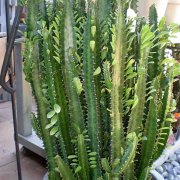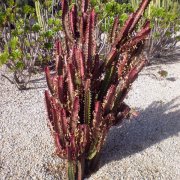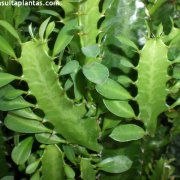Care of the succulent plant Euphorbia trigona or African Milk Tree |
|
The genus Euphorbia, family Euphorbiaceae, includes 2,000 species of succulents, trees, shrubs, and herbaceous plants of cosmopolitan distribution. Some species are: Euphorbia trigona, Euphorbia viguieri, Euphorbia meloformis, Euphorbia lomelii, Euphorbia tithymaloides, Euphorbia stenoclada, Euphorbia obesa, Euphorbia mammillaris, Euphorbia lactea, Euphorbia ingens, Euphorbia inermis, Euphorbia horrida, Euphorbia heptagona, Euphorbia handiensis, Euphorbia grandicornis, Euphorbia flanaganii, Euphorbia enterophora, Euphorbia enopla, Euphorbia echinus, Euphorbia coerulescens, Euphorbia characias, Euphorbia bubalina, Euphorbia candelabrum, Euphorbia canariensis, Euphorbia balsamifera. Common names: African Milk Tree, Cathedral cactus, Abyssinian euphorbia, High chaparall, African milk weed, Cowboy-kaktus. This species is native to Central Africa, Angola, Malawi and Gabon. They are curious succulent plants with a branched columnar habit that become bushy with age and reach 4 meters (13.12 feet) in height. They have 3-4 very marked ribs with small spines on the edge. In the upper part of the plant there are some leaves, 5 cm (1.96") long, shaped like a spatula. They do not produce flowers. African Milk Tree is used in succulent gardens, as isolated specimens, in pots for terraces and patios, and as a houseplant and greenhouse. Euphorbia trigona prefers light shade exposure avoiding the sun's rays in the hottest hours of the day. It does not resist temperatures below 10 ºC (50 ºF); if it's cold or drought, it loses its leaves. The soil can be a mixture, in equal parts, of coarse siliceous sand and leaf mulch. Water moderately, waiting for the substrate to dry. Fertilize with a little compost in late winter or early spring. Cathedral cactus does not need pruning. Euphorbia trigona can be attacked by whiteflies in case of drought or by fungi if there is excess watering. Abyssinian euphorbia propagates by seeds sown in spring or by cuttings in summer. You have to be very careful with the irritating latex of these plants and protect yourself well with gloves. |
Images of the succulent plant Euphorbia trigona or African Milk Tree |
Find plants
Euphorbia trigona or African Milk Tree | Care and Growing
© 2026 FavThemes




